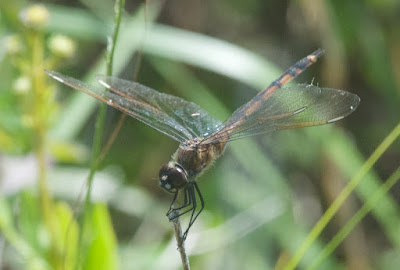We started our final day of our drive to Florida (April 28, 2016) with a tour of the Kennedy Space Center near Titusville. As a child I had watched Sputnik I pass over our house in Jamaica, and as a teenager I followed the American space program religiously, watching every shot I could on live television. At the Space Center, seeing such things as a genuine Saturn V rocket, the Atlantis space shuttle and Alan Shepard’s space suit, still blotched with moon dust, was an emotional experience.
Nature, in some form or another, is all around the center. As we disembarked a Roseate Spoonbill (Platalea ajaja) flew overhead, and our bus tour was interrupted by a Gopher Tortoise (Gopherus polyphemus) crossing the road in front of us. I was unable to photograph either one - but here is the most extraordinary bit of nature on display there: an actual piece of the moon, available for visitors to touch. A humbling experience for even the most jaded naturalist.
After leaving the Space Center, my travelling companions indulged me with a bit of more earthbound nature watching. This involved heading back to the mainland, turning north, driving back out to the northern entrance to the Merritt Island National Wildlife Refuge, and following the seven-mile, one-way Black Point Wildlife Drive.
Late afternoon is not ideal for wildlife-watching, especially when the temperatures reached the high 80s (that’s north of 30 for metric fans). Perhaps, as a result, there was comparatively little to see - no mammals, and no birds that I could not have seen more easily in our usual Floridian haunts further south. This little gang of Glossy Ibises (Plegadis falcinellus) were among the few to allow reasonably close viewing.
There were, however, dragonflies in abundance. The first one I photographed turned out to be a new species for me: the Marl Pennant (Macrodiplax balteata). I was particularly interested to see it, both because Macrodiplax dragonflies are among the few adapted to saltwater coasts, and because the only other Macrodiplax in the world, the Asian M. cora, is one that I had encountered in Sarawak, most recently on the beach at Damai.
The drive takes you through saltmarsh and low mangroves, and the only local dragonfly that is supposed to be able to breed in such conditions was another species I had not previously seen, the Seaside Dragonlet (Erythrodiplax berenice).

Younger males (as I believe these are), like young Seaside Dragonlets, have yet to acquire the greyish-blue pruinosity of full adulthood. At first their wing spots, too, are on the faint side...
...but they darken up with age.
An altogether larger and heavier- bodied dragonfly is the Red Saddlebags (Tramea onusta), named for the (supposedly) saddlebag-like markings at the base of the hindwings.
For a final touch, here is a attractive flower common on the refuge: Indian Blanket, or (perhaps more politically correctly) Blanket Flower (Gaillardia pulchella).




















No comments:
Post a Comment